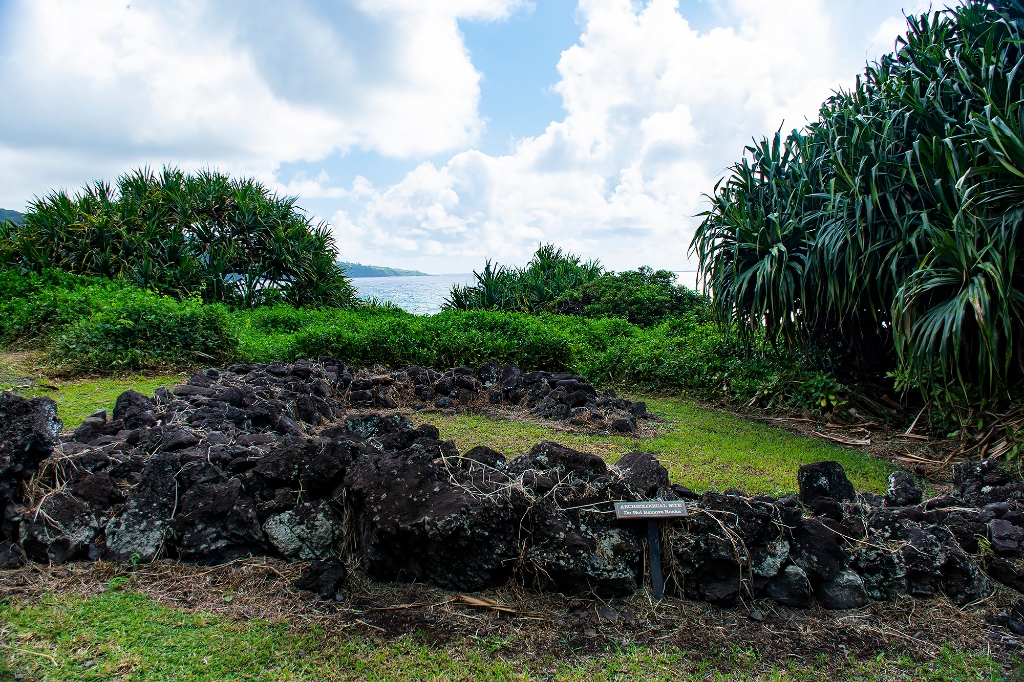
Kīpahulu began as a coastal village. Walking along Kūloa Point Trail provides an opportunity to witness formations built by diligent and skilled hands hundreds, perhaps even a thousand years ago. They voyaged from distant Polynesian islands to the Hawaiian islands, eventually creating what we know as a distinct Hawaiian culture and settling in Kīpahulu (likely around the 12th century).
Two archeological sites welcome you as you approach the view shed of the Alenuihāhā Channel along the coast of Kīpahulu. First, you will come across a small ahu called a koʻa or fish shrine. Kīpahulu is said to be home of Laka, the god of the canoe makers. Chief ʻUmi from Hawaiʻi Island employed Lulana, a canoe maker from Kīpahulu. It was said that “no canoes equaled the canoes of Lulana in the days of ʻUmi or of the ancient chiefs before him.” ʻUmi thus named Lulana "chief over all canoe experts or poʻe kahuna kalaʻi on Hawaiʻi Island." Before launching their waʻa (canoes) into the sea, fishers leave offerings at koʻa to ensure a good catch and safe journey. The next site you will see is a hale noa (sleeping house.) We discussed these types of houses earlier when we stopped at the hale hālāwai.
Continue to the next stop to learn how Hawaiian children are taught to respect the power of water in their home.
Two archeological sites welcome you as you approach the view shed of the Alenuihāhā Channel along the coast of Kīpahulu. First, you will come across a small ahu called a koʻa or fish shrine. Kīpahulu is said to be home of Laka, the god of the canoe makers. Chief ʻUmi from Hawaiʻi Island employed Lulana, a canoe maker from Kīpahulu. It was said that “no canoes equaled the canoes of Lulana in the days of ʻUmi or of the ancient chiefs before him.” ʻUmi thus named Lulana "chief over all canoe experts or poʻe kahuna kalaʻi on Hawaiʻi Island." Before launching their waʻa (canoes) into the sea, fishers leave offerings at koʻa to ensure a good catch and safe journey. The next site you will see is a hale noa (sleeping house.) We discussed these types of houses earlier when we stopped at the hale hālāwai.
Continue to the next stop to learn how Hawaiian children are taught to respect the power of water in their home.
Is there something we missed for this itinerary?
Itineraries across USA

Acadia

Arches National Park

Badlands

Big Bend

Biscayne

Black Canyon Of The Gunnison

Bryce Canyon

Canyonlands

Capitol Reef

Carlsbad Caverns

Channel Islands

Congaree

Crater Lake

Cuyahoga Valley

Death Valley

Dry Tortugas

Everglades

Gateway Arch

Glacier

Grand Canyon

Grand Teton

Great Basin

Great Smoky Mountains

Guadalupe Mountains

Haleakalā

Hawaiʻi Volcanoes

Hot Springs

Indiana Dunes

Isle Royale

Joshua Tree

Kenai Fjords

Kobuk Valley

Lassen Volcanic

Mammoth Cave

Mesa Verde

Mount Rainier

North Cascades

Olympic

Petrified Forest

Pinnacles

Rocky Mountain

Saguaro

Shenandoah

Theodore Roosevelt

Virgin Islands

Voyageurs

White Sands

Wind Cave

Yellowstone

Yosemite

Zion